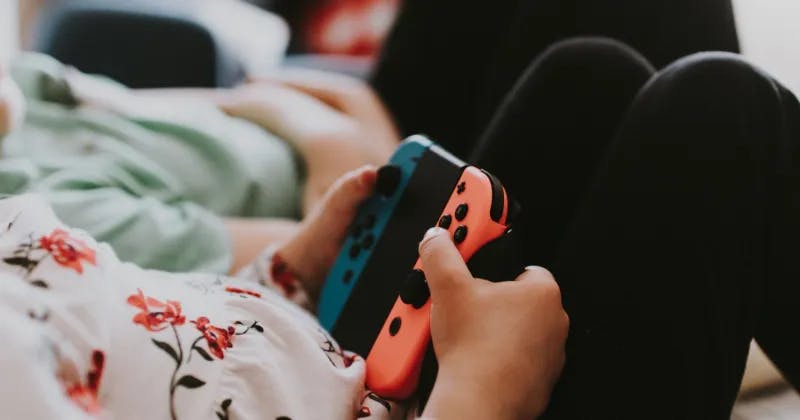Online gaming and video games: tips for keeping your kids safe
Last updated on Thursday, December 03, 2020 | By Craig Gibson

Worried about the impact of gaming on your kids?
With 81% of children in Australia aged 8 to 17 having played an online game or video game there is no denying that they are part of modern childhood. But just how dangerous or harmful are Fortnite and newcomers Among Us, Roblox or the hundreds of other games out there? They are obviously great fun, but you do need to to help them manage risks so they stay safe online and have a positive gaming experience.
[ml]
Let’s start by looking at the new game on the block, Among Us.

If you haven’t come across Among Us yet, this role playing action/strategy game - think Cluedo on a spaceship in traditional board game world - is played by around 60+ million people every day.
It is based around ‘good’ crewmates trying to accomplish set tasks, while 'imposters' attempt to sabotage these missions and murder the crew, with anywhere from four to 10 players in a game. The crew vote on who they believe the imposter is via a chat function, and the player with the most votes is kicked out of the game. The chat element is actually essential to the game - as it’s all about the crew working as a team to identify the ‘imposter.’ The big downside is that the chat feature is unmoderated, so your child could be exposed to potentially inappropriate language, behaviour and interactions.
As a parent the other negative aspects of the game you need to know about include:
[ml]
In addition eSafety.gov.au points out that there is currently no way to report a user in-game for inappropriate behaviour.
Kidsbook Among Us safety tips: We recommend younger children play Among Us in ‘private mode’ with people they know or you have approved. To do this you need to select the ‘local’ option of the game - as opposed to the public option. ‘Local’ play creates a code which you share with real-life friends and creates a private, safe zone - where strangers have no way of accessing. If you are going to let your (older) children play Among Us then there is a setting to filter out inappropriate language, though it can easily be turned off.
In terms of an age rating, Common Sense Media and Google Play recommends 10+, while on Apple’s App Store the game has a 9+ rating.
Now let's take a closer look at the major risks out there for your child when they game online.

Research from Australia’s very own eSafety Commissioner shows that 52% of kids have played online games with people they did not know, while 17% have experienced bullying or abuse while playing a network game with others. One of the other potential dangers is online child grooming - where adults can take on a false identity with the objective of striking up a friendship or connection with a child - often with a sexual objective in mind.
Unfortunately cyberbullying is also a reality, especially in a multiplayer gaming environment where it can take place via an in-game chat feature. We also shouldn’t gloss over the fact that online gaming can be addictive, especially when it begins to dominate their life to the detriment of everything else in their life. Other dangers lurking in some games include references to gambling or they could have gambling themes built into them, including features like ‘loot’ boxes or in-game currency.
It’s not all bad news though…

Gaming does have a bad rap, though it is not all justified - in fact new research from Oxford University points out playing video games can be, ‘positively associated with well-being’, while other studies have highlighted benefits such as:
[ml]
The other stereotype - of the socially isolated gamer locked in their bedroom, is also not wholly accurate, with some researchers pointing out that +70 percent of gamers play with a friend, and multiplayer games have created huge virtual social communities.
But - there are warning signs to look out for so you can do something about it sooner rather than later.

If your child starts showing any of the following behaviours they are very likely to be spending too much time gaming:
[ml]
We should also bear in mind that a child may have an underlying problem like depression or anxiety, which is exacerbated or triggered by spending too much time online.
So, how do you keep them safe?
If you are happy for your children to play games online there a number of steps you can take to keep them safe, including:
[ml]
Want to learn more? There are a ton of resources to help you keep your children safe online, including a dedicated section on gaming from eSafety (AU), Stay Safe Online (USA) and we also have an article on how to keep your kids safe while they video chat online.
With 81% of children in Australia aged 8 to 17 having played an online game or video game there is no denying that they are part of modern childhood. But just how dangerous or harmful are Fortnite and newcomers Among Us, Roblox or the hundreds of other games out there? They are obviously great fun, but you do need to to help them manage risks so they stay safe online and have a positive gaming experience.
Quick read:
[ml]
- [li indent=0 align=left]Educate them about the dangers that exist online.[/li][li indent=0 align=left]Monitor what games they are playing, and make sure they are age appropriate.[/li][li indent=0 align=left]Set limits and stick to them.[/li][li indent=0 align=left]Be aware about the chat feature in games could expose your child to strangers.[/li]
Let’s start by looking at the new game on the block, Among Us.

Among Us: what parents need to know
If you haven’t come across Among Us yet, this role playing action/strategy game - think Cluedo on a spaceship in traditional board game world - is played by around 60+ million people every day.
It is based around ‘good’ crewmates trying to accomplish set tasks, while 'imposters' attempt to sabotage these missions and murder the crew, with anywhere from four to 10 players in a game. The crew vote on who they believe the imposter is via a chat function, and the player with the most votes is kicked out of the game. The chat element is actually essential to the game - as it’s all about the crew working as a team to identify the ‘imposter.’ The big downside is that the chat feature is unmoderated, so your child could be exposed to potentially inappropriate language, behaviour and interactions.
As a parent the other negative aspects of the game you need to know about include:
[ml]
- [li indent=0 align=left]Cartoon-like violence with weapons.[/li][li indent=0 align=left]Unmoderated play which allows children to chat and interact with strangers.[/li][li indent=0 align=left]The chat function cannot be turned off as it's a key feature of the gameplay.[/li][li indent=0 align=left]Players can use unmoderated - read: unsuitable for children - usernames.[/li][li indent=0 align=left]The game has in-app purchases.[/li]
In addition eSafety.gov.au points out that there is currently no way to report a user in-game for inappropriate behaviour.
Kidsbook Among Us safety tips: We recommend younger children play Among Us in ‘private mode’ with people they know or you have approved. To do this you need to select the ‘local’ option of the game - as opposed to the public option. ‘Local’ play creates a code which you share with real-life friends and creates a private, safe zone - where strangers have no way of accessing. If you are going to let your (older) children play Among Us then there is a setting to filter out inappropriate language, though it can easily be turned off.
In terms of an age rating, Common Sense Media and Google Play recommends 10+, while on Apple’s App Store the game has a 9+ rating.
Now let's take a closer look at the major risks out there for your child when they game online.

Risks of online gaming
Research from Australia’s very own eSafety Commissioner shows that 52% of kids have played online games with people they did not know, while 17% have experienced bullying or abuse while playing a network game with others. One of the other potential dangers is online child grooming - where adults can take on a false identity with the objective of striking up a friendship or connection with a child - often with a sexual objective in mind.
Unfortunately cyberbullying is also a reality, especially in a multiplayer gaming environment where it can take place via an in-game chat feature. We also shouldn’t gloss over the fact that online gaming can be addictive, especially when it begins to dominate their life to the detriment of everything else in their life. Other dangers lurking in some games include references to gambling or they could have gambling themes built into them, including features like ‘loot’ boxes or in-game currency.
It’s not all bad news though…

It’s not all bad news…
Gaming does have a bad rap, though it is not all justified - in fact new research from Oxford University points out playing video games can be, ‘positively associated with well-being’, while other studies have highlighted benefits such as:
[ml]
- [li indent=0 align=left]Problem-solving skills.[/li][li indent=0 align=left]Creativity enhancer.[/li][li indent=0 align=left]Mood and relaxation booster.[/li][li indent=0 align=left]Stress buster.[/li]
The other stereotype - of the socially isolated gamer locked in their bedroom, is also not wholly accurate, with some researchers pointing out that +70 percent of gamers play with a friend, and multiplayer games have created huge virtual social communities.
But - there are warning signs to look out for so you can do something about it sooner rather than later.

Online gaming warning signs
If your child starts showing any of the following behaviours they are very likely to be spending too much time gaming:
[ml]
- [li indent=0 align=left]Singular, obsessive focus on a game.[/li][li indent=0 align=left]Poor academic performance.[/li][li indent=0 align=left]Withdrawing from socialising with friends and family.[/li][li indent=0 align=left]No interest in sport.[/li][li indent=0 align=left]Poor sleep habits, and often tired and irritable.[/li][li indent=0 align=left]Experiencing headaches and eye strain.[/li][li indent=0 align=left]Not eating like they used to.[/li][li indent=0 align=left]Neglecting their personal hygiene.[/li][li indent=0 align=left]Mood swings and anger issues related to gaming.[/li]
We should also bear in mind that a child may have an underlying problem like depression or anxiety, which is exacerbated or triggered by spending too much time online.
So, how do you keep them safe?
Online gaming: manage the risks
If you are happy for your children to play games online there a number of steps you can take to keep them safe, including:
[ml]
- [li indent=0 align=left]Research games before you let your kids play.[/li][li indent=0 align=left]Monitor the time your child spends online, and agree on set times when they can game, with consequences for not switching off.[/li][li indent=0 align=left]Be aware of any changes to their behaviour, including withdrawing from family life.[/li][li indent=0 align=left]Get them to play in the family or games/tv room, as opposed to their bedroom. This way you can keep an eye on what they are accessing. [/li][li indent=0 align=left]Check the game classifications and/or age guidelines for specific games or apps.[/li][li indent=0 align=left]Get involved and game with your kids, that way you have some insight into what they are doing online.[/li][li indent=0 align=left]Encourage your child to tell you if they experience anything online that worries them or makes them uncomfortable.[/li][li indent=0 align=left]Educate them about about in-app purchases and the cost of games.[/li][li indent=0 align=left]Get them to use anonymous screen names, and not to reveal their real name and/or birthdate .[/li]
Want to learn more? There are a ton of resources to help you keep your children safe online, including a dedicated section on gaming from eSafety (AU), Stay Safe Online (USA) and we also have an article on how to keep your kids safe while they video chat online.


